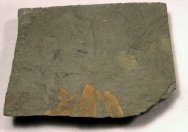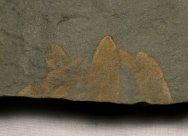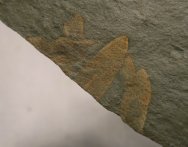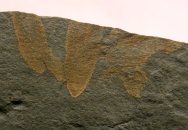| 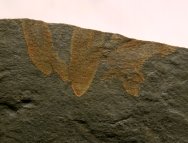 Description:
Diagonella belongs to the family Protospongiidae, which was a group
of early and primitive sponges of the Class Hexactinellida. Diagonella
was attached to the sea floor by long spines at the base of the
sponge. These spines are rarely preserved. The six-rayed spicules
were not fused into a net, so were relatively fragile as a result.
These sponges are very rare in the Burgess Shale of British Columbia,
and sponges are relatively uncommon in the fossil record owing to
their delicacy. This specimen exhibits unusually fine preservation. Description:
Diagonella belongs to the family Protospongiidae, which was a group
of early and primitive sponges of the Class Hexactinellida. Diagonella
was attached to the sea floor by long spines at the base of the
sponge. These spines are rarely preserved. The six-rayed spicules
were not fused into a net, so were relatively fragile as a result.
These sponges are very rare in the Burgess Shale of British Columbia,
and sponges are relatively uncommon in the fossil record owing to
their delicacy. This specimen exhibits unusually fine preservation.
Sponge
fossils from the Cambrian Explosion are found in various Cambrian
sites in North America, most notably the Burgess Shale of Canada,
and the Cambrian strata of Utah, unlike this specimen, which comes
from a new location. Many sponges are also described from the Chengjiang
biota of China. Sponges are believed to have undergone repeated
radiations in the Phanerozoic, and probably attained their largest
diversity in the Cretaceous.
This
assemblage of five examples comes from the Comet Shale Member of
the Pioche Formation of Nevada. This deposit spans the transition
of Early to Middle Cambrian which saw the extinction of the Olenellid
trilobites. It is just younger than the comparable material from
the Chengjiana Biota of Yunnan Province, China and just older than
the Burgess Shale Fauna of British Columbia, Canada. The specimens
are often somewhat faint, as here. The specimen has been water wet
to heighten contrast in the last photographs. Regardless, this is
a rare specimen, little seen outside of an academic collection.
Most of the outcrops are on BLM land which is not available for
collecting. This material however comes from a ranch on private
land.
Reference:
A New Soft-bodied Fauna: The Pioche Formation of Nevada, Bruce S.
Lieberman, Journal of Paleontology, Jul 2003.
|

